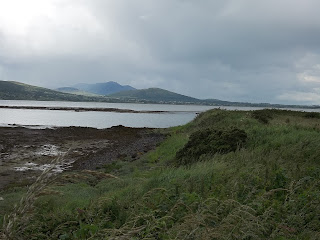 |
| Just some photos taken from the airplane as we left Dublin. |
Thursday, August 09, 2012
Ireland Trip - Carlingsford Lough
Ireland Trip - Port/Lurganboy Beach
 |
| Our last day was cool and rainy but we went out to the Irish Sea anyway. |
 |
| Of course we had to go dip our fingers and toes in the water. |
 |
| I think the tide was out as we had to walk across the beach for quite a ways to get to the water. |
 |
| There were other brave souls on the beach. |
 |
| I'm assuming a clam or some other creature that lives in the sand created these piles when they excavated their home. |
 |
| The beach was covered in them. |
Ireland Trip - Newgrange, Knowth and Bru na Boinne Visitor Center
 |
| From the World Heritage Ireland website: |
The archaeological landscape within Brú na Bóinne is dominated by the three well-known large passage tombs, Knowth, Newgrange and Dowth, built some 5,000 years ago in the Neolithic or Late Stone Age. An additional ninety monuments have been recorded in the area giving rise to one of the most significant archaeological complexes in terms of scale and density of monuments and the material evidence that accompanies them. The Brú na Bóinne tombs, in particular Knowth, contain the largest assemblage of megalithic art in Western Europe.
 |
| The next four photos are from the Visitor's Center and contain information about the history of the site. |
 |
| Art work on one of the stones. The stairs are where we entered the mound. |
 |
| Double-click to enlarge to read the history of the mounds. |
 |
| The other end of the passage. |
 |
| View from atop the mound. |
 |
| The Entrance Stone. During the winter solstice, light comes in the box above the door and lights up the cross-shaped chamber. |
Ireland Trip - Trim Castle
 |
| Once in the gate, I photographed the grounds, starting on the right, while we waited for our tour of the keep. The following photo tells you about this photo. |
 |
| The side of the River Gate. |
 |
| The River Gate from a different angle. |
 |
| Scenes from the movie Braveheart were filmed on the other side of this curtain Wall and outside the Barbican Gate. |
 |
| Inside the Barbican Gate. |
 |
| Jolene and I both took photos of the foliage growing from the ruins of the Barbican Gate. |
 |
| More of the curtain wall to the right of the Barbican Gate. |
 |
| The side of the keep facing the curtain wall and Barbican Gate. |
 |
| View from the Barbican Gate looking back to the River Gate and the Solar. |
 |
| View from up in the castle. The ruin in the background was a church, I think. |
 |
| This is the gate they used to bring the sheep onto the castle grounds. |
 |
| The roof of the castle is not intact so these tent structures are used to protect the inside, mainly the tourists, from rain. |
Subscribe to:
Comments (Atom)






































